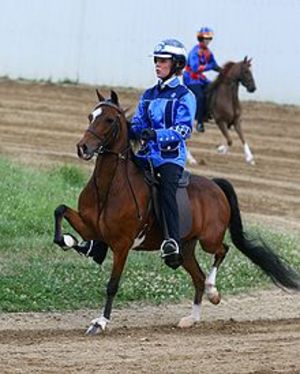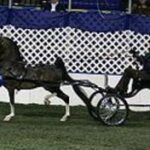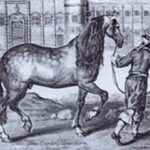Hackney ponies should ideally look like smaller versions of the Hackney horse. If you’re not familiar with the Hackney horse breed, don’t panic. A Hackney pony is a separate breed from the Hackney horse, but both breeds share the same registry association. Some people claim that Hackney ponies exhibit a better trotting action than the Hackney horses. Both breeds originated in England but have a big following in North America.
A Tiny Horse
A Hackney pony looks like a delicate show off; more art form than real horse. They can walk, canter and gallop like other horses, but they have been bred to trot in an exaggerated way. Noted author Marguerite Henry noted in Album of Horses (1962) that their knees practically hit their chin whiskers. Although developed to excel at harness, Hackney ponies can be ridden.
Hackney ponies range from 12.2 to 14.2 hands high, although larger and shorter animals occur. However, in order to be shown as a Hackney Pony and not a Hackney horse, the show pony must be over 12.2 and not larger than 14.2 hands high. They mostly come in solid colors (mostly various shades of bay or chestnut) but many have flashy white markings.
Although they are called ponies, they do not have the body proportions of a pony. Their bodies are slimmer, their foreheads are les broad than a pony and the legs are longer. Their weight even reflects their lighter bodily structure. They weigh only about 500 to 600 pounds. Most other breeds of pony of the same size would weigh about 800 pounds.
Hackney ponies can be tightly wound, fine-limbed equines and a lot of potential health problems. Although Hackney ponies generally love people, this is not a breed for someone who wants to get their first pony. If you are not used to handling an animal that gets easily spooked, then both you and the Hackney pony are looking to get involved in a spectacular accident. These are definitely not ponies for young children.
Because of their high action, they tend to get a lot of leg and hoof injuries and problems. Not all of their high trotting action is natural. Often they are trained to lift their legs even higher through the use of artificial devices such as weights and chains. The use of these devices can also lead to injury, as noted by Heather Smith Thomas in The Horse Conformation Handbook (Storey Publishing, 2005.)
Hackney ponies cannot grow the incredibly thick winter coat of other pony breeds, so they need to be kept inside during rough weather. Their coats, manes and tails are more like a Thoroughbred than like a typical pony. In character, Hackney ponies are more like Thoroughbreds than a pony. They can be prone to bad habits like nipping, stall weaving and cribbing unless they are given a proper diet, regular exercise and a lot of sympathetic handling. Only the best equine handlers can earn the trust of a Hackney pony.
Additional References
- International Encyclopedia of Horse Breeds. Bonnie Hendricks. University of Oklahoma Press, 1995.
- Encyclopedia of Horses and Ponies. Tasmin Pickeral. Paragon; 2003.
- Storey’s Illustrated Guide to 96 Horse Breeds of North America. Judith Dutson. Storey Publishing; 2005.






